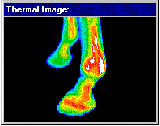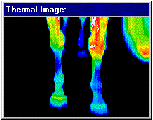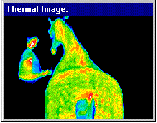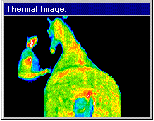Phase 1 Medical Thermal Imaging, LLC. | home
Welcome | How it Works | Sample Report | Sample Report - continued | Indications for a Themographic Evaluation | Horse Fact | Contact Us
Sample Report - continued

The neuro-thermography application of DITI measures the somatic component of the sympathetic nervous system by assessing dermal blood flow. The sympathetic nervous system is stimulated at the same anatomical location as its sensory counterpart and produces a 'somato sympathetic response'. The somato sympathetic response appears on DITI as a localized area of altered temperature with specific features for each anatomical lesion.

Skin blood flow is under the control of the sympathetic nervous system. In normal subjects (asymptomatic) there is a symmetrical dermal pattern which is consistent and reproducible for any individual. This is recorded in precise detail to a temperature sensitivity of 0.01°C by the Meditherm vet2000 DITI system.
The mean temperature reduction in peripheral nerve injury is 1.5°C. Rheumatological processes generally appear as 'hot' areas with increased temperature patterns, the pathology is generally an inflammatory process, i.e. synovitis of joints and tendon sheaths, periosteal damage and muscle injuries, etc.

Both hot and cold responses may co exist if the pain associated with an inflammatory focus excites an increase in sympathetic activity. Also, vascular conditions are readily demonstrated by DITI including Vasculitis, limb ischemia, DVT, etc.

"Early inflammation of a stressed tendon can be detected up to 2 weeks earlier than by routine clinical examination".

Reproduction of material from this page without written permission is strictly prohibited
Last updated on 02/21/2001 1:22 PM PDT
Copyright © 2000-2001 Phase 1 Medical Thermal Imaging, LLC.

